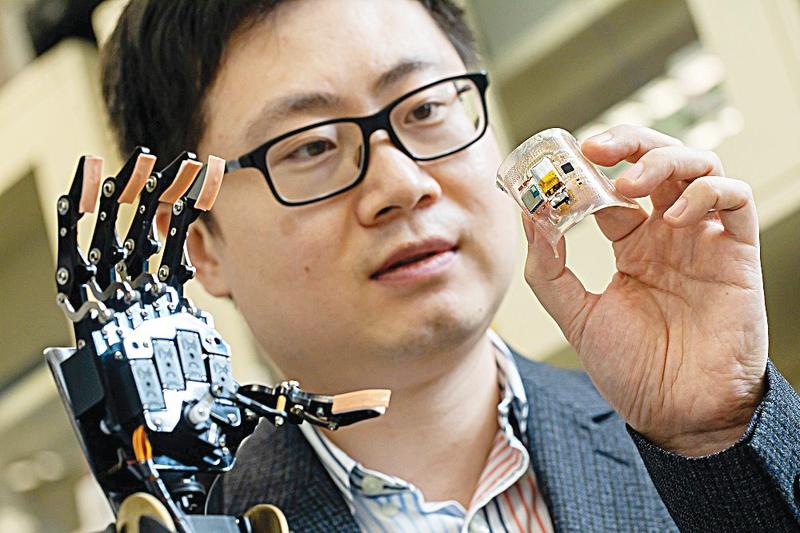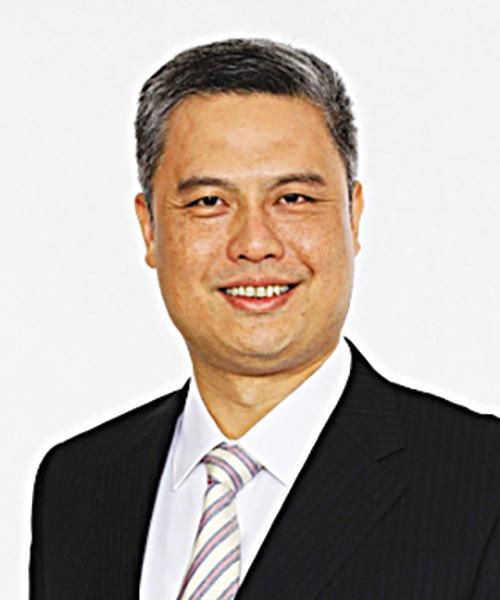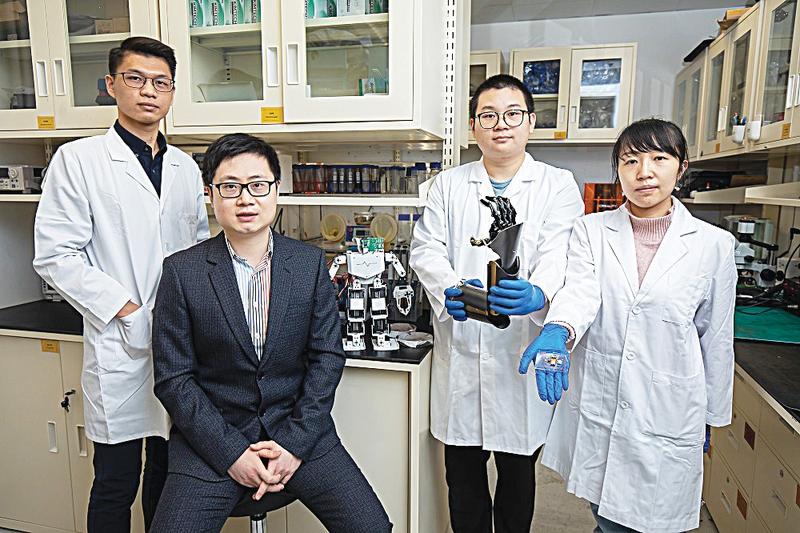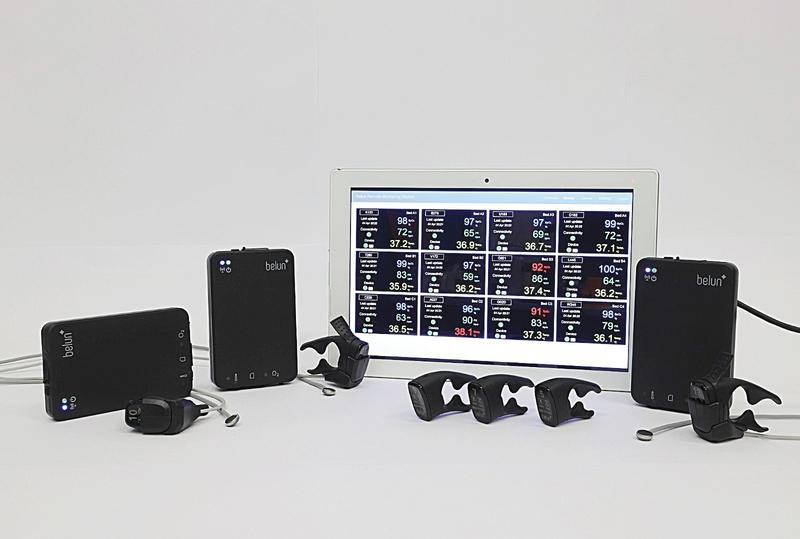High technology has gained extra prominence in HK’s bid to contain the COVID-19 outbreak. Advanced healthcare systems and robotic devices have helped to speed up detections and reduce infection risks. Su Zihan and Ao Yulu report.
 Yu Xinge displays the flexible, multilayered electronic skin developed by his team. (PHOTO PROVIDED TO CHINA DAILY)
Yu Xinge displays the flexible, multilayered electronic skin developed by his team. (PHOTO PROVIDED TO CHINA DAILY)
Advanced science and technology is playing an integral role not only in Hong Kong’s bid to shore up its innovation prowess but, more distinctly, in the uphill battle against the city’s worst wave of the COVID-19 pandemic that broke out at the end of 2021 and has since infected around 1.07 million residents. High technology’s contributions are omnipresent as the special administrative region goes the extra mile in mobilizing all its forces and resources to contain the virus.
As a key driving force behind the new round of technological revolution and industrial upgrades, the application of artificial intelligence stands out in controlling and curbing the outbreak and treating patients, after intensive transformation from research to application scenarios.
 The skin is the cornerstone of the new Robotic VR system. The sensors on the robotic hands provide haptic feedback to the user. (PHOTO PROVIDED TO CHINA DAILY)
The skin is the cornerstone of the new Robotic VR system. The sensors on the robotic hands provide haptic feedback to the user. (PHOTO PROVIDED TO CHINA DAILY)
A research team co-led by the City University of Hong Kong has come up with an innovative human-machine interface system, in which teleoperated robots can imitate carrying out nucleic acid tests on people and doing other complicated tasks. This makes it possible for medical workers to conduct such tests remotely and treat patients with infectious diseases.
The system, called Robotic VR, is based on skin-integrated electronics that interface with the human body for wireless motion, capturing the haptic feedback through the internet or Bluetooth.
Doctors wearing electronic and virtual reality glasses can remotely control the teleoperated robots and experience the tactile sensations of the robots. They’re then able to collect biosamples, conduct surgeries and look after infectious patients, thus greatly reducing the risk of infection, said Yu Xinge, associate professor at CityU’s Department of Biomedical Engineering.
 Rocky Cheng Chung-ngam, a co-founder of the information platform that provides Hong Kong residents with COVID-related information. (PHOTO PROVIDED TO CHINA DAILY)
Rocky Cheng Chung-ngam, a co-founder of the information platform that provides Hong Kong residents with COVID-related information. (PHOTO PROVIDED TO CHINA DAILY)
“The electronic devices are stretchable and can be tightly mounted on the human skin and even the whole human body for a long time. In addition, the interface provides both haptic and visual feedback systems, offering an immersive experience for medical personnel.”
Conventional robots used to collect bio-samples would transmit the image of a patient’s condition through a camera. Doctors would then carry out tests based on the images. The lack of haptic feedback for doctors limits the application for performing complex tasks, said Yu.
The sensors of the Robotic VR system, meanwhile, can accurately detect and convert subtle human motion into electronic signals, and send feedback signals to control the vibration intensity of the haptic actuators wirelessly, providing haptic feedback and enabling doctors to precisely control and adjust the motion and strength of the robot, especially of its arms.
 Yu Xinge (front row) and his research team at CityU, namely (back row from left) Yiu Chun-ki, Liu Yiming, and Huang Ya. (PHOTO PROVIDED TO CHINA DAILY)
Yu Xinge (front row) and his research team at CityU, namely (back row from left) Yiu Chun-ki, Liu Yiming, and Huang Ya. (PHOTO PROVIDED TO CHINA DAILY)
According to Yu, the system can be operated remotely worldwide without any geographical restrictions via the internet. “There may be a short delay in remote operation via the internet but, with Bluetooth technology, local operation within a few dozen meters is very accurate and stable.”
The system supports three wireless transmission methods — Bluetooth (up to tens of meters), Wi-Fi (up to about 100 meters), and the internet (worldwide) — which can be adjusted according to the practical applications.
Yu’s team is also developing a new device to be installed in e-security gates, with the technology to detect the COVID-19 infection in the air when the virus carriers pass through the gate, even with their mask on. It would automatically report a positive case in seconds.
The new technology would enable rapid screening of patients at airports or customs checkpoints, thus saving significant costs in deploying manpower, said Yu. He hopes the technology could be put into use soon to help ease the pressure on human resources and reduce infection risks through transportation.
 Lydia Leung Lap-wai demonstrates how a Belun Technology product is worn. (PHOTO PROVIDED TO CHINA DAILY)
Lydia Leung Lap-wai demonstrates how a Belun Technology product is worn. (PHOTO PROVIDED TO CHINA DAILY)
Technology enterprises are also ramping up efforts to help Hong Kong get through this difficult time.
Hong Kong-based startup Belun Technology has developed a healthcare monitoring system, which consists of a ring-sized wearable device that can monitor a user’s health status, as well as a communication hub that can report the real-time physical data of the user.
A person’s oxygen saturation rate, pulse rate and body temperature can be probed and captured via the wearable ring and then transmitted to and demonstrated on a mobile phone application.
The product has been provided for people with intellectual impairments and elderly residents in nursing homes.
“It’s difficult for them (the elderly and people with intellectual disabilities) to be aware of the risk of infection and take measures in time,” said Lydia Leung Lap-wai, CEO of Belun Technology. “The device would alert the nursing staff — when the indicator goes beyond the normal range — that the condition of a person with mild symptoms of COVID-19 is at risk of deteriorating.”
Other high-tech applications, such as 5G technology and mobile robots, have also been used in Hong Kong’s anti-pandemic fight. China Mobile Hong Kong has teamed up with technology company OTG OnTheGo in providing mobile robots that can distribute daily supplies without coming into direct contact with residents in Sham Shui Po. Autonomous robots have greatly reduced the workload of community workers and infection risks.
 The Belun Technology ring detects and records a person’s oxygen saturation rate, pulse rate and body temperature. (PHOTO PROVIDED TO CHINA DAILY)
The Belun Technology ring detects and records a person’s oxygen saturation rate, pulse rate and body temperature. (PHOTO PROVIDED TO CHINA DAILY)
The remarkable growth in Hong Kong’s technology and innovation capability has been demonstrated not only in its rapid development of anti-pandemic “hardware”, but also in “software”.
A one-stop online platform was recently launched to help residents access COVID-related information. StandByU provides updated data and information on COVID-19, such as protection tips and whether reservations at testing and vaccination centers are full.
“There are many volunteers to search, check and update the latest data and information. So, members of the public can get information quickly from just one website rather than from various channels,” said Rocky Cheng Chung-ngam, who co-founded the information platform and is also chief information officer at Bank of China (Hong Kong).
The platform also provides specific information for vulnerable groups, such as children and the elderly. “Sometimes, it takes time for ordinary people to differentiate fake news from real news, especially the elderly,” said Cheng.
Contact the writers at suzihan@chinadailyhk.com


